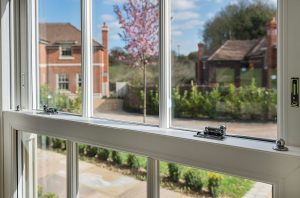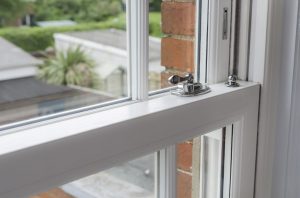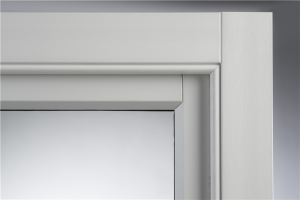From 1st July European Union regulations make it is mandatory for most construction products, including replacement double glazed windows, to carry the ‘CE’ mark.
In this third regular feature, our consultant town planning expert looks at some of the possible implications of this for good design, town planning and the protection of traditional British architectural character. Don’t worry, our sash windows are CE marked as standard.
The ‘CE’ mark and the Construction Products Regulations
The Construction Products Regulations (CPR) came fully into effect on 1st July 2013. CE marking is intended to harmonise the conformity of construction products traded and used within the European Union. Construction products (with a few specified exceptions) must now carry a ‘CE’ mark – similar to that we’ve seen on kitchen ‘white goods’ such as cookers and fridges for sometime (A – H rating).
The ‘CE’ mark declares the manufacturer of the product is satisfied that it meets health, safety and environmental performance standards expected within Europe.
On the face of it this appears to be a good thing for the consumers and the global environment. Inevitably there is additional legal responsibility, costs and burden on the product manufacturer but you might say that is unavoidable and necessary?
However, experts point to several problems in the application of the ‘CE’ marking methodology for which it is possible ‘to use cheats’ (as the gaming generation would say) and more fundamentally, as to whether the CPR requirement should apply to ‘bespoke’ made-to-order products like replacement double glazed windows, at all?
Others are better qualified than me to comment on these problems in detail and no doubt the debate will build now the CE marking requirement is upon us….but to summarise some of the key issues that have been pointed out to me by experts:
First, the burden the CPR creates, are wide and complex and it seems unlikely that the new legal obligations have been fully understood by all window manufactures, or installers especially those fitting glass supplied by one manufacturer into new frames supplied by another, builders or ‘micro businesses’ (less than 10 employees) who might have thought they enjoyed an exemption from this. Did you know it is now illegal to advertise construction products on the web without the necessary a CE mark in place?
Second, where construction products (such as replacement windows) are assembled using products produced by others, then a rating for the assembled product can be ‘derived’ from the source manufacturer’s documentation. But this rating will be highly doubtful and the methodology for assessing details items such as the impact of glazing bars on the thermal performance of a whole window is highly arbitrary; it overrides or even ignores other far more significant factors (see further explanation below).
Third, does ‘CE’ marking really add anything? Manufacturers are already required to declare product performance against European Standards (formerly the British Standards) and European Technical Assessments (such as that by the British Board of Agreement (BBA)) which tell us about the performance of building products on a far broader basis than required by the ‘CE’ mark. We also have the Building Regulations which look at the appropriate specification for a construction product to be used in a given design situation (e.g. should a particular window be specified to enable fire escape).

So what does this all mean for good architectural design and town planning and what type of construction products do we need for good design and town planning?
Good architectural design and town planning aims to improve the energy efficiency and performance of buildings and places, while respecting important and distinctive local character and architectural features. We want to keep what makes buildings and places special to people whilst moving forward.
Looking closely at the development of both national and local planning policies over the last 10-15 years we can see a clear shift in priorities; from protecting heritage at the foremost, to a wider balancing concern for the wider environmental, social and economic dimensions, mitigation of climate change, and the encouragement of innovation, energy efficiency and renewable new materials.
However, clear aesthetic limits remain – this encouragement of ‘the new’ should NOT be at the cost of serious harm to important distinctive local building character and heritage. The new National Planning Policy Framework is clear that we should consider to the ‘significance’ of our ‘heritage assets’ and respond in our designs accordingly – whether it’s a highly prized Grade 2 Listed Building of vernacular design and construction or a more common but cherished street of ‘1930’s semi’s ’.
So we need a wide range of high performance construction products; including replacement double glazed windows that ‘look right’ in our local traditional and heritage buildings. There is not and should not be a standard ‘Euro-window’ style.
What are the implications of ‘CE’ marking for good town planning?
Customers and salespeople looking at replacement windows will be familiar with the ‘CE’ marking approach; it appears trustworthy and the ratings given are simple to follow – without needing to understand ‘what goes on under the bonnet’.
Customers and salespeople are likely to place great emphasis on it in the decision making, this is where some of the technical limitations of the methodology used in ‘CE’ marking and it’s application to replacement windows come to the fore.
For example, the thermal transmittance of windows (U Value) is measured using the European Standard (EN 14351-1). This European Standard is based on a typical, single pane (but double glazed) window, as widely found in mainland Europe – without glazing bars. This is different to traditional British windows, in which glazing bars are far more common and indeed important to our local traditional characters, aesthetic appeal and design.
The European Standard (Annex J of EN 14351-1) applies a rather rude and arbitrary adjustment factor to the calculation of the U Value of a single pane(double glazed) window, to establish the U Value performance for those with vertical, or grid glazing bars. Technical experts have shown me how crude these factors are, exaggerating and heavily weighing against their use by making unreasonable reductions to the U value and therefore the ‘CE’ marked energy rating of a double glazed window. Yet
these glazing bars are what add authenticity to double glazed windows. This methodology far and away overrides or even ignores other far more important considerations such as the size of the window, the method of installation, and quality of design details.
The danger is people will focus overly on a the misleading ‘CE’ rating over other indicators and factors, which will dissuade customers from specifying the glazing bar features that can be vital to achieving the visual appearance and qualities that are aesthetically necessary for good visual design and planning.
No doubt the debate will continue about the methodology used ‘under the bonnet’ in the ‘CE’ marking and indeed and whether ‘bespoke’ made to measure replacement windows should carry a ‘CE’ mark at all.
In my opinion the double glazing window industry has largely moved on from the ‘bad old days’ of crude replacement windows, wrecking the traditional appearance of our housing – the danger of ‘CE’ marking, is that unless we are very careful about its use, it could be a retrograde step backwards?!
And today I’ve only looked at replacement windows; what about the implications for other construction products…..?
These views are those of
Michael Thornton MRTPI
Merit Thornton Planning Ltd
Regrettably we are unable to answer any specific planning issue however we do try to offer general answers on the blog, please add your comment.






